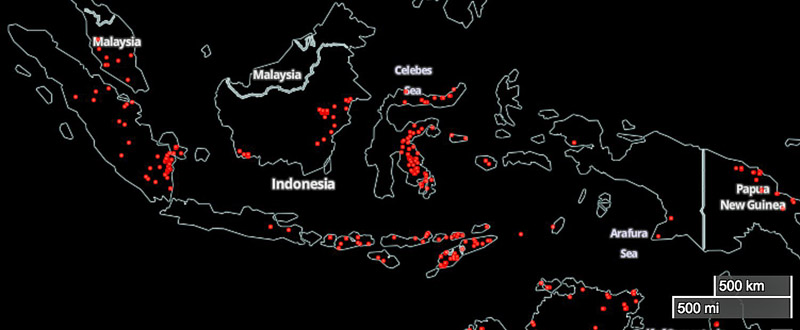
The Guardian has an excellent long-form article about wildland fires, titled ‘A deranged pyroscape’: how fires across the world have grown weirder. Author Daniel Immerwahr writes that in banishing fire from sight, we have made its dangers stranger and less predictable. He writes about fires around the world, pyrophobia, indigenous fire, and how hundreds of thousands die each year from such smoke-related maladies as strokes, heart failure and asthma.
Toward the end of the article he writes about fires in Indonesia where forests have been drained, burned, or clear cut, then summarizes.
Here is an excerpt:
…No single one of Indonesia’s many fires in recent decades has been especially noteworthy. But altogether they’ve been cataclysmic. In 1997, a dense haze of airborne particulates from Indonesia’s fires was perceptible as far as the Philippines and Thailand. That year, on Sumatra – centre of Indonesia’s fires – a commercial plane crashed due to poor visibility and killed all 234 aboard. The next day, two ships collided off the coast of Malaysia for the same reason, and 29 crew members died.
The economist Maria Lo Bue found that Indonesians who were toddlers during the 1997 haze grew less tall, entered school six months later and completed almost a year less of education than their peers. Another economist, Seema Jayachandran, found that the fires “led to over 15,600 child, infant and fetal deaths”, hitting the poor especially hard.
Picture a dangerous fire and you’re likely to imagine a thicket of tall trees blazing in a drought-stricken climate. But a more accurate image is smoldering peat or scrub burning by a tropical logging road. The real threat isn’t catching fire, but the slow violence of breathing bad air. You’ve got a hacking cough, your father suffers a stroke and you watch your daughter – short for her age – leave school a year early.
—
Fire is not in itself a bad thing. Many landscapes, built to burn, simply couldn’t exist without regular fires, either natural or intentional. Though foresters once sought to tamp blazes out everywhere, we now recognise that as a grave mistake. A fireproof planet isn’t something we can get, or should even want.
We badly need a healthier relationship to combustion. Rather than erratic, runaway fires, we need regular, restorative ones, like we used to have. Our forebears didn’t shun flame – they were relentless fire-setters. But they adhered to two important limits. First, they fed their fires with living vegetation, which reclaims lost carbon as it regrows. Second, they were guided by long-acquired experience with fire’s complex paths and consequences.
We’ve blasted far past both of those limits. We’re now burning fossilized vegetation, which sends carbon on a one-way trip to the warming atmosphere. And we’re kindling fires that bear little resemblance to the ones we’re used to. There’s no generational wisdom telling us what to do when we drain the peatlands of Central Kalimantan or let dry fuel pile up precariously in the California countryside, all while raising the temperature to hitherto unrecorded heights.
Books about fire typically end with prescriptions: we must invest in science, reclaim lost cultural knowledge, burn intentionally, build resiliently, and power our grids renewably. All that is true, surely. But given how complex fire is, and how unprecedented nearly everything we’re doing with it is, the best advice would seem to be: slow down. We have scrambled our landscape, changed our energy diet, altered the climate and revised our relationship to flame, all in a very short time. It’s not a surprise that fire, once a useful if obstinate companion to our species, has now slipped our grasp.
The world won’t burn up, as we sometimes imagine. But the fires of tomorrow will be different from those of yesterday, and we’re racing headlong into that unsettling future, burning tankfuls of gas as we go.
Thanks and a tip of the hat go out to Tom.





